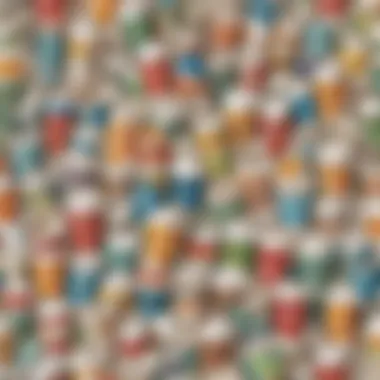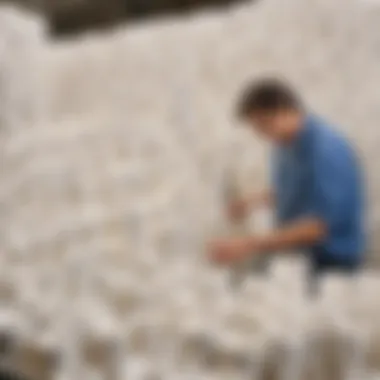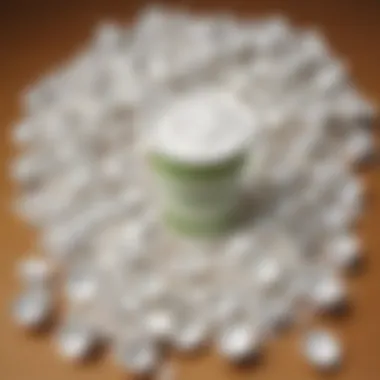Unveiling the Environmental Impact of Styrofoam Cups: A Detailed Analysis


Science Fun Facts
Styrofoam, a type of plastic foam, is commonly used in the production of cups due to its lightweight and insulating properties. Did you know that Styrofoam is actually a trademarked brand name for polystyrene foam, which is a petroleum-based plastic material known for its non-biodegradable nature? This means that once discarded, styrofoam cups can persist in the environment for hundreds to thousands of years. Imagine the long-lasting impact of a simple cup!
Discover the Wonders of Science
When we delve into the realms of environmental science, we uncover the intricate web of consequences associated with seemingly everyday items like styrofoam cups. By exploring scientific concepts such as biodegradability, ecological footprints, and sustainable materials, we gain a deeper understanding of the importance of responsible choices in our daily lives. Through educational materials and real-life examples, we can empower ourselves to make informed decisions that benefit both our planet and future generations.
Science Quiz Time
Let's challenge our knowledge with some thought-provoking questions about styrofoam cups and their environmental impact. How long does it take for a styrofoam cup to break down in the environment? What are some eco-friendly alternatives to using styrofoam cups? By engaging in interactive quizzes and brain teasers, we can not only test our understanding but also broaden our perspectives on sustainability and environmental stewardship.
Science Experiment Showcase
In a hands-on exploration of environmental conservation, we can conduct experiments that showcase the effects of styrofoam on ecosystems. Step-by-step instructions, materials lists, safety tips, and precautions guide us through experiments that highlight the importance of conscious consumption and waste management. By immersing ourselves in these engaging activities, we not only learn practically but also foster a deeper sense of responsibility towards our environment.
Introduction
Styrofoam cups may seem innocuous in our daily lives, but their impact on the environment is profound and far-reaching. This article meticulously explores the intricate web of consequences woven by Styrofoam cups across their lifecycle. From their origins to their ultimate disposal, we unravel the layers of environmental implications inherent in every Styrofoam cup's existence.
Overview of Styrofoam Cups
Composition of Styrofoam
The chemical composition of Styrofoam, a petroleum-based plastic, lies at the core of its characteristics and environmental footprint. Polystyrene, the primary component of Styrofoam, is lauded for its lightweight nature and insulating properties, making it a sought-after material particularly in the food and beverage industry. Despite its usefulness, the non-biodegradable nature of polystyrene poses a significant challenge to ecosystem health and sustainability. Understanding the intricacies of Styrofoam's composition sheds light on the urgency of seeking eco-friendly alternatives.


History of Styrofoam Cups
Delving into the historical trajectory of Styrofoam cups unveils a narrative of convenience and cost-effectiveness overshadowing concerns for environmental impact. Introduced in the 20th century as a revolutionary packaging solution, Styrofoam cups quickly gained popularity due to their affordability and durability. However, with increasing awareness of plastic pollution and ecological harm, the history of Styrofoam cups serves as a cautionary tale, prompting a reevaluation of our consumption patterns and waste management practices.
Purpose of the Study
Importance of Examining Styrofoam Cups
The significance of scrutinizing Styrofoam cups transcends mere material analysis; it embodies a critical stance toward sustainability and environmental consciousness. By delving into the intricacies of Styrofoam cup production, usage, and disposal, we unmask the hidden costs of convenience associated with single-use plastics. This exploration not only informs but also empowers individuals, businesses, and policymakers to make informed choices that prioritize planetary well-being over momentary convenience.
Research Objectives
The research objectives outlined in this study aim to delve into the nuances of Styrofoam cup utilization and its environmental repercussions systematically. By setting clear research goals, we aim to delineate the carbon footprint, waste generation, and potential alternatives associated with Styrofoam cups. Through empirical evidence and data-driven analysis, we endeavor to present a holistic view of Styrofoam cups' impact on the environment, motivating stakeholders to adopt sustainable practices and advocate for meaningful change.
Production Process
In this article, the Production Process section plays a pivotal role in dissecting the lifecycle of Styrofoam cups, from creation to disposal. It is essential to unravel the intricacies of how these ubiquitous cups are manufactured, used, and discarded. By delving into the Production Process, we can gain valuable insights into the environmental ramifications of Styrofoam cup production and consumption, highlighting the need for sustainable alternatives.
Manufacturing of Styrofoam Cups
Raw Materials
The Raw Materials used in Styrofoam cup production are fundamental to understanding their environmental impact. Polystyrene, a synthetic polymer derived from petroleum, is the primary component of Styrofoam cups. Its lightweight nature and insulating properties make it a popular choice for beverage containers. However, the extraction and processing of petroleum raise concerns about carbon emissions and resource depletion. While Polystyrene offers cost-effectiveness and convenience, its non-biodegradable nature poses a significant challenge to environmental sustainability. The Raw Materials section sheds light on the trade-offs between functionality and ecological consequences, urging a reevaluation of material choices in the packaging industry.
Processes Involved
Exploring the Processes Involved in manufacturing Styrofoam cups provides a deep dive into the energy-intensive procedures that transform raw materials into finished products. From polymerization to molding, each step in the production process demands significant amounts of energy and resources. The use of additives and chemicals further complicates the environmental footprint of Styrofoam cup production. While these processes enable mass production and cost-efficiency, they also contribute to greenhouse gas emissions and environmental pollution. By dissecting the intricacies of the Processes Involved, we uncover the hidden environmental costs associated with our daily reliance on disposable plastic items, triggering reflections on sustainable consumption practices.


Environmental Impact
In delving into the profound examination of the impact of styrofoam cups on the environment, it is crucial to understand the intricate web of consequences and repercussions that stem from the production, utilization, and disposal of these ubiquitous objects. Styrofoam, composed of polystyrene, has been a contentious material due to its significant environmental footprint. By scrutinizing this impact, we uncover layers of complexity that are pivotal in paving the way towards sustainable practices and alternative solutions that are crucial for our ecosystem.
Carbon Footprint
Emissions During Production
The emissions generated during the production of styrofoam cups play a pivotal role in understanding their environmental impact. These emissions, predominantly carbon dioxide and other greenhouse gases, contribute significantly to the carbon footprint associated with styrofoam. It is imperative to note the energy-intensive processes involved in the creation of these cups, leading to a substantial release of greenhouse gases into the atmosphere. While lightweight and cost-effective, the manufacturing of styrofoam cups comes at a high environmental cost, necessitating a closer evaluation of its sustainability in the larger environmental discourse.
Impact on Climate Change
The impact of styrofoam cups on climate change is a critical aspect that cannot be overlooked in the environmental impact narrative. The excessive production and disposal of these cups contribute to the overall carbon emissions and exacerbate the greenhouse effect, intensifying global warming. By shedding light on this crucial connection, we accentuate the importance of embracing sustainable alternatives that can mitigate the adverse effects of styrofoam cups on our planet. Understanding the direct correlation between styrofoam usage and climate change is paramount in fostering a more environmentally conscious society.
Waste Generation
Disposal Challenges
The disposal of styrofoam cups presents significant challenges due to their non-biodegradable nature. These cups, once discarded, persist in the environment for hundreds of years, accumulating in landfills and water bodies. The lightweight and insulating properties of styrofoam make it resistant to natural degradation processes, posing immense disposal challenges. Addressing these challenges requires a paradigm shift towards sustainable waste management practices and promoting the adoption of eco-friendly alternatives to reduce the burden on our ecosystem.
Landfill Accumulation
The contribution of styrofoam cups to landfill accumulation is a pressing concern that underscores the urgency of reevaluating our consumption patterns. With billions of styrofoam cups ending up in landfills annually, the accumulation of non-biodegradable waste poses a severe threat to environmental sustainability. These cups take up valuable space in landfills and leach harmful chemicals into the soil, further contaminating the environment. By delving into the repercussions of landfill accumulation, we illuminate the imperative need for reimagining packaging solutions and embracing materials that align with the principles of a circular economy.
Alternatives to Styrofoam Cups
In the quest for sustainable consumption, the exploration of alternatives to Styrofoam cups surfaces as a critical focal point. As society becomes more environmentally conscious, the significance of transitioning away from non-biodegradable materials like Styrofoam towards eco-friendly options cannot be overstated. The shift towards eco-conscious choices in everyday items like beverage containers portrays a conscious effort towards reducing our environmental impact and fostering a greener future. By delving into the realm of alternatives to Styrofoam cups, individuals and businesses can actively participate in mitigating the detrimental effects of non-biodegradable products on our planet.


Biodegradable Options
Compostable Materials
Within the sphere of alternative choices, compostable materials emerge as a promising solution to the environmental concerns posed by Styrofoam cups. Compostable materials, derived from organic sources, exhibit the remarkable ability to decompose naturally without leaving behind harmful residues. Their contribution lies in the creation of a closed-loop system wherein waste materials can break down and return to the earth as nutrients. The key characteristic of compostable materials is their eco-friendly nature, ensuring minimal environmental harm upon disposal. The unique feature of compostable materials is their ability to seamlessly integrate back into the ecosystem, offering a sustainable approach to managing waste. While compostable materials present numerous advantages in reducing pollution and promoting a circular economy, challenges may arise in terms of availability and cost-effectiveness, considerations that warrant further exploration.
Reusable Solutions
Conversely, reusable solutions stand out as a practical alternative to disposable Styrofoam cups, emphasizing longevity and resource efficiency. By opting for reusable containers such as stainless steel tumblers or glass mugs, individuals can significantly minimize their contribution to single-use waste. The distinctive feature of reusable solutions lies in their durability and reusability, traits that align with the principles of sustainable living. Not only do reusable options reduce the need for continuous production and disposal, but they also encourage a culture of conscious consumption. While the advantages of reusable solutions are evident in waste reduction and cost savings over time, potential disadvantages may involve maintenance requirements and initial investment, aspects that require evaluation in the pursuit of sustainable choices.
Promoting Sustainable Practices
Encouraging Eco-Friendly Choices
At the core of promoting sustainable practices lies the concept of encouraging eco-friendly choices, where individuals are nudged towards selecting products and materials with minimal environmental impact. The key characteristic of this approach is its educational dimension, aiming to inform consumers about the implications of their purchasing decisions on the environment. By highlighting the benefits of eco-friendly alternatives like biodegradable or reusable cups, the narrative shifts towards conscious consumerism and its ripple effects on sustainability. The unique feature of encouraging eco-friendly choices is its potential to instigate widespread behavioral change towards more sustainable consumption patterns. While the advantages include reduced plastic pollution and resource conservation, challenges may surface in terms of changing entrenched habits and fostering widespread adoption of eco-conscious products.
Community Initiatives
Parallel to individual efforts, community initiatives play a pivotal role in driving sustainable practices and fostering collective action towards environmental conservation. Community initiatives center around collaborative endeavors aimed at implementing eco-friendly policies, organizing cleanup drives, and supporting local businesses that promote sustainability. The key characteristic of community initiatives is their communal aspect, uniting individuals with a shared goal of preserving the environment for future generations. By mobilizing grassroots efforts, these initiatives spark a sense of environmental stewardship and social responsibility within communities. The unique feature of community initiatives lies in their potential to create lasting structural changes in societal attitudes towards sustainability, paving the way for a greener and cleaner tomorrow. While the advantages encompass strengthened social cohesion and heightened environmental consciousness, challenges may manifest in terms of resource mobilization and maintaining long-term engagement in community-driven sustainability projects.
Conclusion
In examining the Impact of Styrofoam Cups on the Environment, it is crucial to understand the significant environmental repercussions associated with the production, usage, and disposal of these ubiquitous items. The harmful effects of styrofoam cups on the ecosystem cannot be overstated, making it imperative for individuals and businesses to reevaluate their consumption patterns. By delving into the various facets of styrofoam cup usage, from manufacturing to environmental degradation, this article aims to raise awareness and foster a sense of responsibility towards sustainable practices.
Summary of Findings
Implications for Environmental Conservation
The Implications for Environmental Conservation section underscores the critical need for adopting eco-friendly alternatives to styrofoam cups. By reducing the usage of non-biodegradable materials like styrofoam, individuals can significantly decrease their carbon footprint and minimize waste accumulation in landfills. Embracing sustainable practices, such as opting for compostable materials or reusable solutions, can lead to a notable positive impact on the environment. The emphasis on environmental conservation through conscientious consumption is a defining feature of this article, highlighting the fundamental role individuals play in preserving ecological balance.
Call to Action
The Call to Action segment serves as a catalyst for change, urging readers to act upon the insights gleaned from this exploration. Encouraging a shift towards sustainable practices, such as supporting community initiatives and making eco-friendly choices, is paramount for long-term environmental preservation. By fostering a sense of empowerment and shared responsibility, the call to action implores individuals to become stewards of the environment, effecting tangible change through conscious decision-making. This proactive approach delineates a pathway towards a more sustainable future and underscores the actionable steps needed to mitigate the adverse effects of styrofoam cup usage.







